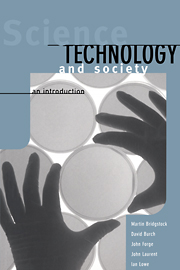Book contents
- Frontmatter
- Contents
- List of Figures
- List of Tables
- List of Contributors
- Preface
- Part One Scientific and Technological Communities
- Part Two Scientists and Technologists in the Wider Society
- 6 The Industrial Revolution in Great Britain
- 7 Science, Technology and the Economy
- 8 Science, Technology and Economic Theory
- 9 Science, Technology and Public Policy
- 10 Science, Technology and the Less-developed Countries
- 11 Science, Technology and the Future
- Appendix 1 Surviving in the Information Jungle
- Appendix 2 Referencing
- Index
8 - Science, Technology and Economic Theory
Published online by Cambridge University Press: 04 February 2010
- Frontmatter
- Contents
- List of Figures
- List of Tables
- List of Contributors
- Preface
- Part One Scientific and Technological Communities
- Part Two Scientists and Technologists in the Wider Society
- 6 The Industrial Revolution in Great Britain
- 7 Science, Technology and the Economy
- 8 Science, Technology and Economic Theory
- 9 Science, Technology and Public Policy
- 10 Science, Technology and the Less-developed Countries
- 11 Science, Technology and the Future
- Appendix 1 Surviving in the Information Jungle
- Appendix 2 Referencing
- Index
Summary
This chapter complements the last two by outlining some major ways in which economists have sought to understand the relationships between science, technology and the economic system. The economic impact of science and technology is probably the major reason why governments pay so much attention to these factors, as shown in Chapters 2, 6, 7 and 9. Equally, economists have expended much effort trying to understand how new knowledge, and new technology, fit into economics. Some surprising results have emerged: for one thing, the orthodox approach to economics has not proved very useful in understanding technological innovation and change, although it has continued to make major impacts in other areas (e.g. Becker 1976). For another thing, following one of the major themes of this book, it has become clear that where knowledge is produced in the economy, and how it is linked to business and industry, are crucial in determining the economic outcomes.
It is a characteristic of industrial societies that we tend to take for granted the flow of new products and processes, such as computers, drugs and food products, but this was not always so. As we saw in Chapters 6 and 7, science did not begin to influence industry directly until the middle of the nineteenth century. Technology has always been important to humanity, but in the past, change was much slower: entire generations might pass and experience little that was new or innovative (Clark 1985:27).
- Type
- Chapter
- Information
- Science, Technology and SocietyAn Introduction, pp. 159 - 180Publisher: Cambridge University PressPrint publication year: 1998



